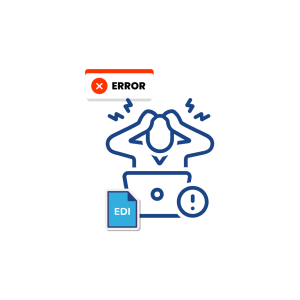Define Supply Chain
First lets start off with What does Supply Chain Mean?
To put it simply, a supply chain is a system that allows a manufactured product to reach a consumer in one or many steps.
The 5 components of a supply chain:
- Planning
- Manufacturing
- Assembling
- Packaging
- Transporting
- Delivery & Return
Top 15 Supply Chain Terminologies
1. E-commerce
It is an industry where the buying and selling of products or services is conducted via electronic systems such as the Internet and other computer networks. Electronic commerce draws on technologies such as mobile commerce, electronic funds transfer, supply chain management, Internet marketing, online transaction processing, order processing, inventory management systems, and automated data collection systems.
2. Electronic Data Interchange (EDI)
Electronic Data Interchange is the exchange of large amounts of information computer-to-computer in a specified format between business partners.
3. Blanket Order
A method in which the buyer agrees to buy a certain quantity from its supplier to allow multiple delivery dates over some time, often negotiated to take advantage of predetermined pricing. It is normally used when there is a recurring need for expendable goods.
4. Distribution Center (DC)
The distribution center is a warehouse or other specialized building, often with refrigeration or air conditioning, which is stocked with goods to be redistributed to retailers, wholesalers, or directly to consumers. A distribution center is a central part of the order fulfillment process.
5. Bonded Warehouse
A bonded warehouse is a location managed by the customs office or a government body, where businesses may store taxable goods and imports subject to duties for business purposes. The business will only need to pay taxes at the time of removing the goods from the warehouse. This is particularly useful for retailers who import a lot of goods into the country since it allows them to spread out their tax burden by deferring some tax payments to a later time.
6. Cross-docking
A distribution system in which merchandise received at the warehouse or distribution center is not put away but instead is readied for shipment to retail stores. Cross-docking requires close synchronization of all inbound and outbound shipment movements. By eliminating the multiple steps (put-away, storage, etc.), it can significantly reduce costs. This method is typically used for perishable goods with a short shelf life and goods that are affected by temperature.
7. Drop shipment
Where one of a buyer’s vendors takes the title of the products but does not handle, stock, or deliver it, e.g., to have one supplier ship directly to another or to have a supplier ship directly to the buyer’s customer. This is useful for selling slow-moving items with a long product life, without bearing the burden of storage and maintenance.
8. Waybill
A document prepared by the seller, on behalf of the carrier, that specifies the shipment’s point of origin, the details of the transacting parties (the buyer and seller), the route, and the destination address.
9. Hitchment
The process of combining two or more portions of one shipment that originate at different locations, moving under one bill of lading, from one shipper to one consignee. This process can be done only if the shipments have the same sender and receiver and It’s approved by shipping tariff authorities.
10. Harmonized System (HS) Codes
The Harmonized System Codes are commonly used throughout the export process for goods. The Harmonized System is a standardized numerical method of classifying traded products. It is used by customs authorities around the world to identify products when assessing duties and taxes and for gathering statistics. These codes normally range from 4 to 10 digits, depending on where they are used.
11. Landed Cost
Landed cost is the total amount of money it costs a vendor to create a product then transport it, and have the customer receive it. This not only includes shipping and raw materials, but any additional fees such as import duties, shipping insurance, and other related costs.
12. Back-Ordering
Back ordering is the process of allowing customers to place orders even if there isn’t sufficient stock on hand. It is usually done during times of high demand and/or for slow-moving products that suddenly see a spike in demand.
13. ASN (Advanced Shipping Notification)
ASN is an Information sent from the shipper via Electronic Data Interchange to the customer that communicates the contents of the shipment, shipping time, estimated arrival time etc.
14. Groupage
Refers to the process where multiple shipments are combined to streamline transportation. More than one order with individual Bills of Landing will exist in one shipment or container.
15. FIFO & LIFO
Stands for “First In, First Out” Means that the first shipment received is the first to be sent out. The opposite is LIFO which stands for “Last In, First Out”.
Complete Guide to Supply Chain KPIs
Top 30 Supply Chain KPIs Your Business Should Be Tracking & Measuring
Frequently Asked Questions
Lead Time refers to the period between initiating a process (such as placing an order) and its completion. In supply chain, it encompasses order processing, manufacturing, and transportation, influencing inventory management and customer delivery times.
JIT stands for Just-In-Time, a strategy aiming to minimize inventory levels by receiving goods or producing items precisely when needed. This approach reduces carrying costs and waste while improving efficiency.
SKU stands for Stock Keeping Unit, a unique identifier assigned to distinguish and manage individual products or items in inventory. SKUs streamline tracking and management processes in warehouses and throughout the supply chain.
FIFO stands for First In, First Out. It is a method used to manage inventory, where the oldest items are used or sold first. This helps prevent obsolescence and spoilage, ensuring a more efficient and cost-effective inventory turnover.
Supply Chain Visibility refers to the ability to track and monitor inventory, shipments, and processes in real-time throughout the supply chain. It enhances decision-making, reduces the risk of disruptions, and improves overall responsiveness to changes in demand or supply.





